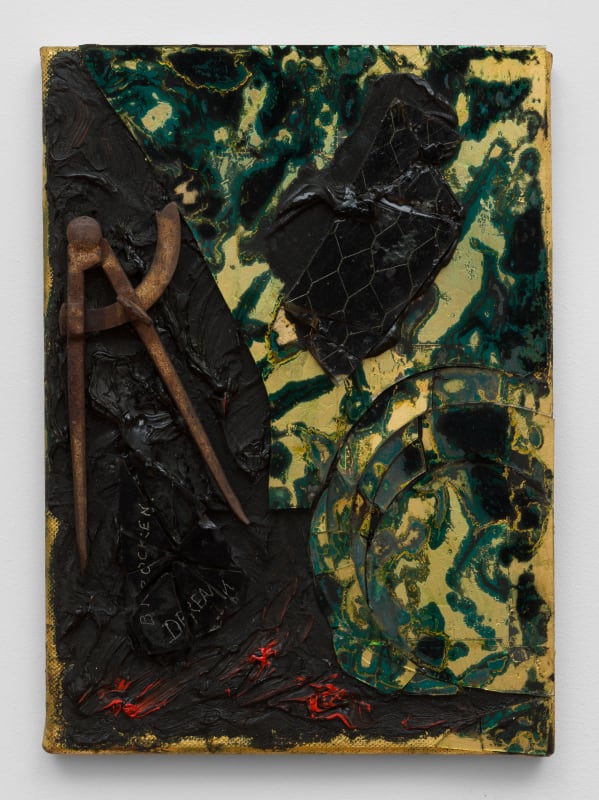Derek Jarman
The Black Paintings : A Chronology
Part I 1984 -1987
6 June – 11 July 2025
The title of the earliest painting in this exhibition Heart's Ease, 1984, refers to the wild pansy flower popular during the Victorian era and thought to represent romantic love. The flower also, however, appears in Shakespeare’s A Midsummer’s Night’s Dream, where its magical aphrodisiac properties cause considerable mayhem. The same year Derek Jarman created this painting, he was working on one of his most beautiful films, The Angelic Conversation, 1985, a love story between two young men, which was shot using Super 8 film and video. The film opens with the sound of a clock ticking and the recitation of one of Shakespeare’s sonnets. Unfolding without recourse to a direct narrative, it uses a black and gold layering of moving imagery to seduce the audience.
This two-part presentation of Derek Jarman’s work traces the development of his Black Paintings, the most significant series of paintings that he produced up to 1991. The chronological thread reveals significant thematic, iconographic and textual parallels between the paintings and the films and writings he produced over the same period. That said, the interrelationship between these co-evolving bodies of works shows that Jarman’s creative approach is by no means linear. The engraving in one of the paintings recalls his interest in the Old English poem The Wanderer. In another, the title Esse in Anima, draws from his fascination with Carl Jung's analytical psychology. References to Wilfried Owen's poem Strange Meeting, 1918, coincide with searing commentary on the politics of 1980s Britain, as in his film The Last of England, 1987. A notable precedent to this approach is the opening scene of his feature film Jubilee, 1977, as Elizabeth I is transported to the future by the alchemist John Dee and finds herself amidst the punks and anarchists of 1970s London. Drawing on historical and literary references, personal history and contemporary politics, Jarman effectively created his own time machine from the mechanics of writing, painting and filmmaking.
The format of the small black paintings share something with Jarman’s black and gold square notebooks – recording memories, photographs and research for his latest projects. They weave together ideas and life experiences, experimenting with the trajectory of time. Similarly, the Black Paintings register the complexity of his thoughts while crystallising the extraordinary nature of Jarman’s multimedia oeuvre.
So I scramble in the rubbish, an archaeologist who stumbles across a buried film. An archaeologist who projects his private world along a beam of light into the arena, till all goes dark at the end of the performance, and we go home. Home is where one should be, as Dorothy said, clicking her ruby slippers, there’s no place like it.
Derek Jarman, The Last of England, 1986
With thanks to the Keith Collins Will Trust
The Black Paintings : A Chronology
Part II 1988 - 1991
16 July – 20 September 2025
The Assassination of Pier Paulo Pasolini in the Garden of Earthly Delights
Derek Jarman
Published by Pilot Press
Perfect bound
148x190mm
96pp
Published in the U.K. by Pilot Press
ISBN: 978-1-0687586-3-8
On the occasion of the opening of this exhibition Pilot Press will launch the publication of Derek Jarman's unrealised film treatment, The Assassination of Pier Paulo Pasolini in the Garden of Earthly Delights, 1984. For the first time, the final draft of the film’s treatment is presented alongside reproductions from the film’s workbook, which show Jarman’s calligraphic notes towards the film’s sequences, themes, cinematography, lighting, sound, costume, casting and props.
Jarman’s treatment takes as its subject matter the events leading up to and including the 1975 murder of the Italian film director, Pier Paulo Pasolini, following the making of his controversial last film Saló, or the 120 Days of Sodom, 1975. The setting of the film takes as its inspiration Hieronymus Bosch’s triptych The Garden of Earthly Delights, 1490-1500, a painting that depicts both the joys and dangers of temptation, and which Jarman encountered on a visit to the Museo de Prado in Madrid the year he began working on the project.

